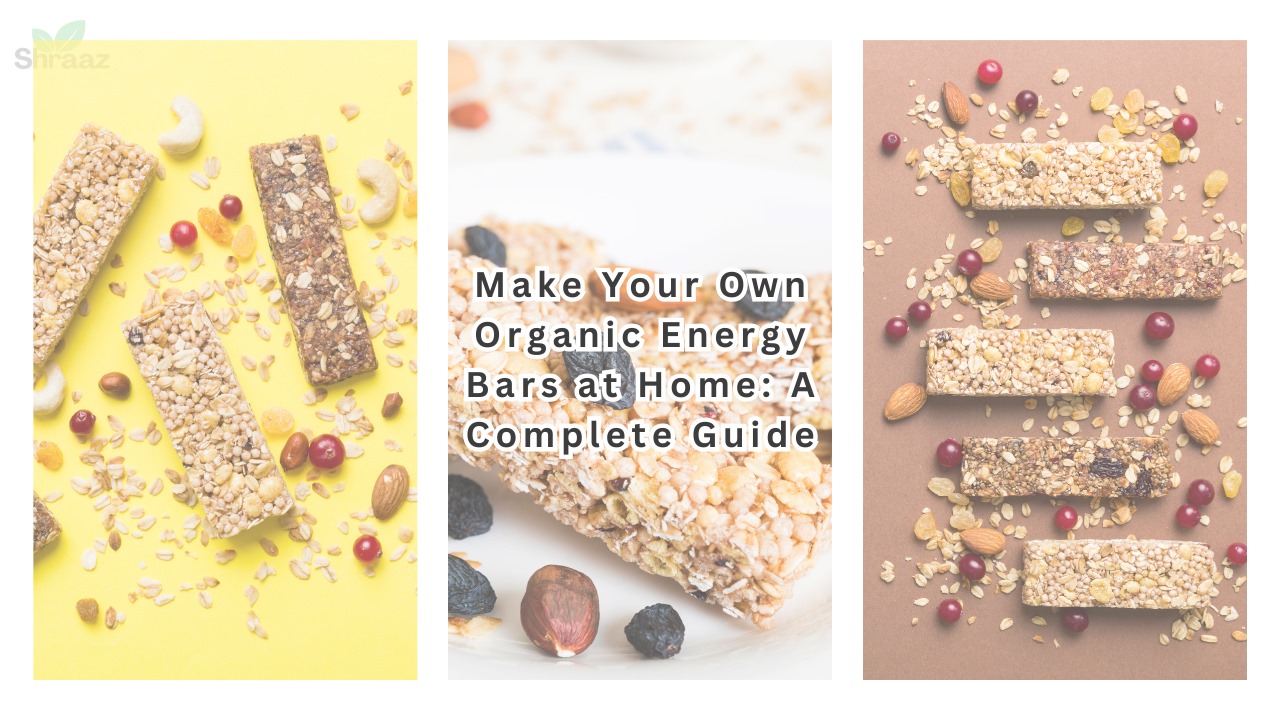Can You Make Organic Energy Bars at Home
In today’s fast-paced world, finding nutritious and convenient snacks can be a challenge. Organic energy bars have become increasingly popular due to their ability to provide quick energy while using wholesome, natural ingredients. But the downside? Store-bought options can be expensive and sometimes laden with unnecessary sugars and preservatives. That’s why making your own organic energy bars at home is an excellent alternative.
Homemade energy bars allow you to control what goes into your body, ensuring that every ingredient is organic, clean, and tailored to your specific dietary needs. Not only are these bars easy to make, but they also offer a more cost-effective solution to maintaining a healthy snack routine. This guide will walk you through everything you need to know about crafting your own organic energy bars at home, from choosing ingredients to storage tips.
For a broader discussion of the overall organic foods beyond just organic energy bars, check out The Complete Guide to Organic Food/Edibles: Benefits, Characteristics, and Future Trends.
Why Choose Organic?
Choosing organic ingredients is not just a health trend—it’s a conscious choice for both your well-being and the environment. Organic foods are grown without the use of synthetic pesticides, fertilizers, and genetically modified organisms (GMOs), making them a healthier choice overall.
Health Benefits of Organic Ingredients
Organic products tend to contain higher levels of nutrients, particularly antioxidants, compared to conventionally grown counterparts. A 2014 meta-analysis published in the British Journal of Nutrition found that organic crops had up to 69% higher concentrations of antioxidants than non-organic crops. These antioxidants play a crucial role in reducing inflammation and fighting oxidative stress in the body.
Additionally, organic foods are often fresher because they don’t contain preservatives that extend shelf life. Organic farming is also beneficial for soil health and biodiversity, as it encourages the use of natural fertilizers and pest control methods.
Environmental Impact
Organic farming methods are better for the environment, as they reduce pollution, conserve water, reduce soil erosion, increase soil fertility, and use less energy. Farming without synthetic pesticides is also better for nearby wildlife and people who live close to farms. In the long run, choosing organic can help sustain the health of ecosystems and the planet.
Organic Certification
When sourcing ingredients for your energy bars, look for organic certifications such as the USDA Organic seal, which ensures that the product meets strict standards for organic farming practices. While organic products may cost slightly more than conventional ones, the health benefits and environmental impact make them worth the investment.
Key Ingredients for Organic Energy Bars
The success of your homemade organic energy bars relies on the quality and balance of ingredients. Every energy bar recipe typically involves a combination of whole grains, nuts, seeds, natural sweeteners, and a binding agent, along with optional superfoods and flavor enhancers.
1. Whole Grains (Base Ingredient)
- Oats: The most common base for energy bars, oats provide fiber, vitamins, and a satisfying texture. Rolled oats or quick oats work well in most recipes.
- Quinoa: A protein-packed alternative to oats, quinoa is a gluten-free option that adds extra texture and nutritional value.
| Whole Grain | Benefits | Example Use |
| Oats | High in fiber and protein | Base for most bars |
| Quinoa | Gluten-free, high in protein | For additional crunch |
2. Nuts and Seeds (Protein and Healthy Fats)
Nuts and seeds are a rich source of healthy fats, proteins, and essential minerals. They not only provide energy but also improve satiety.
- Almonds: High in vitamin E and magnesium.
- Sunflower seeds: A great source of vitamin E and antioxidants.
- Chia and flax seeds: Packed with omega-3 fatty acids and fiber, they help improve digestion.
| Nut/Seed | Nutritional Benefits | Example Use |
| Almonds | Rich in vitamin E and healthy fats | Ground or chopped |
| Sunflower seeds | High in vitamin E, adds crunch | Mixed into base |
| Chia/Flax seeds | High in omega-3 and fiber | Mixed in for texture |
3. Natural Sweeteners
Instead of using refined sugars, homemade energy bars rely on natural sweeteners, which provide energy while adding flavor and acting as a binder.
- Honey: A natural sweetener rich in antioxidants.
- Maple Syrup: Offers a deep, complex sweetness with minerals like zinc and manganese.
- Dates: Naturally sweet and fiber-rich, dates work well as a primary binding ingredient.
| Sweetener | Nutritional Benefits | Example Use |
| Honey | Antioxidant-rich, anti-inflammatory | Sweetener/binder |
| Maple Syrup | Rich in minerals, adds deep flavor | Alternative to honey |
| Dates | High in fiber and potassium | Main binder for bars |
4. Binding Agents
To hold all ingredients together, you’ll need a sticky substance. Nut butters are a popular choice because they add protein and healthy fats.
- Peanut butter: An affordable, protein-rich option.
- Almond butter: Higher in vitamin E than peanut butter, with a more neutral flavor.
5. Optional Superfoods
For an extra nutritional boost, consider adding these superfoods to your bars:
- Cacao nibs: A source of antioxidants and magnesium.
- Goji berries: Packed with vitamins A and C, these add a sweet, tangy flavor.
The Step-by-Step Process
Creating homemade energy bars is surprisingly easy, and it requires only a few simple steps. Here’s a detailed guide to ensure your bars come out perfectly every time.
Step 1: Gather Your Ingredients
Choose your favorite organic ingredients from the categories above. Use the following proportions as a general guide:
- 2 cups of oats or whole grains.
- 1 cup of mixed nuts and seeds.
- ½ cup of natural sweeteners like honey or maple syrup.
- ½ cup of nut butter or a binding agent.
- Optional: ¼ cup of superfoods (e.g., chia seeds, goji berries, cacao nibs).
Step 2: Prepare the Base
- In a large mixing bowl, combine oats, nuts, seeds, and any additional dry ingredients (like cacao nibs).
- Heat the honey or maple syrup over low heat in a saucepan, and stir in the nut butter until fully melted and combined.
Step 3: Mix the Ingredients
- Pour the heated mixture over the dry ingredients and mix well, ensuring that every piece is evenly coated. Use a spatula to thoroughly blend the ingredients.
Step 4: Press into a Pan
- Line a baking tray with parchment paper. Press the mixture evenly into the pan, making sure the surface is smooth and compact.
Step 5: Bake or Chill
- Baked Bars: Preheat your oven to 350°F (175°C) and bake for 15–20 minutes or until the bars are golden brown. Let them cool completely before cutting.
- No-Bake Bars: Place the pan in the fridge and allow the bars to chill for 2–4 hours, or until firm.
Step 6: Cut and Store
- Once firm, remove the bars from the pan and cut them into squares or rectangles. Store in an airtight container.
Recipe Ideas
Creating your own organic energy bars allows you to experiment with flavors, textures, and nutrients tailored to your preferences. Below, you will find a variety of recipes, ranging from classic oat-based bars to more innovative versions featuring superfoods. Each recipe is designed to be easy to follow, with options for various dietary needs.
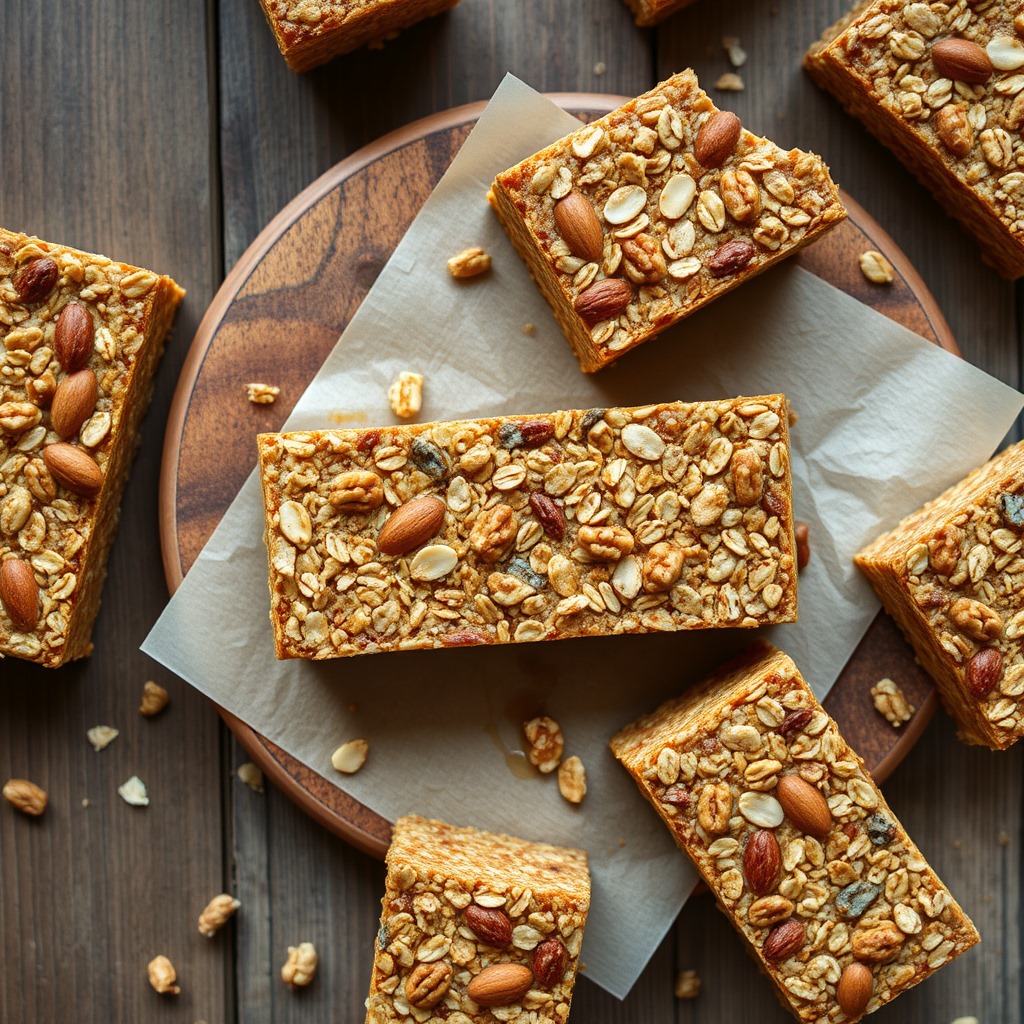
1. Classic Organic Oat and Nut Energy Bars
Ingredients
- 2 cups rolled oats
- 1 cup mixed nuts (almonds, walnuts, cashews)
- ½ cup honey or maple syrup
- ½ cup nut butter (peanut or almond)
- ½ cup dried fruits (raisins or cranberries)
- ½ teaspoon cinnamon (optional)
Instructions
- Preheat your oven to 350°F (175°C).
- In a large bowl, combine oats, chopped nuts, dried fruits, and cinnamon.
- In a saucepan over low heat, combine honey and nut butter until melted and smooth.
- Pour the mixture over the dry ingredients and mix well.
- Press into a lined baking tray.
- Bake for 15–20 minutes until golden.
- Allow to cool completely before cutting into bars.
Nutritional Benefits
- Oats: High in fiber, which helps with digestion.
- Nuts: Provide healthy fats and protein.
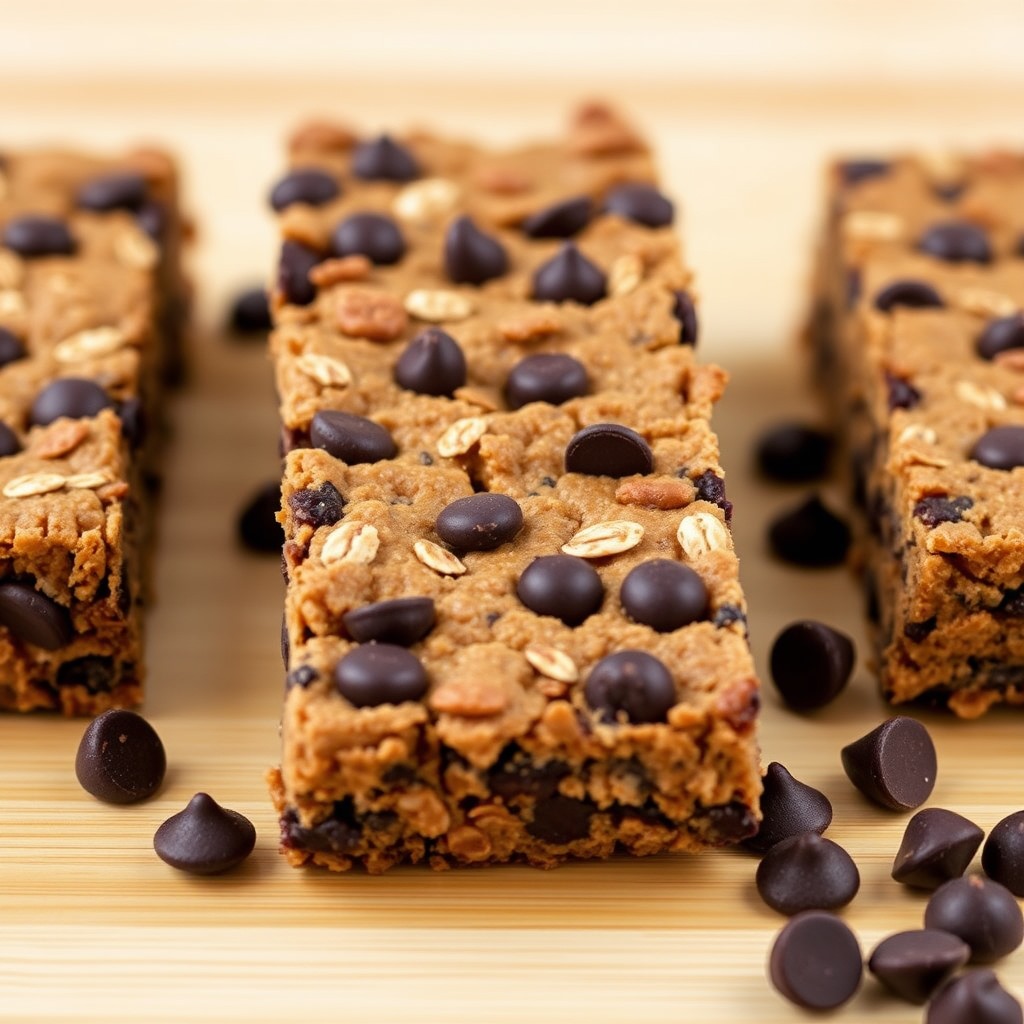
2. Chocolate Chip Protein Bars
Ingredients
- 2 cups rolled oats
- 1 cup protein powder (plant-based or whey)
- ½ cup almond butter
- ½ cup honey or maple syrup
- ½ cup dark chocolate chips
- 1 teaspoon vanilla extract
Instructions
- Preheat oven to 350°F (175°C).
- In a bowl, combine oats and protein powder.
- In a saucepan, heat almond butter, honey, and vanilla until melted.
- Pour the mixture into the dry ingredients and mix well. Stir in chocolate chips.
- Spread into a lined baking pan and bake for 15 minutes.
- Cool and cut into bars.
Nutritional Benefits
- Protein powder: Enhances muscle recovery.
- Dark chocolate: Offers antioxidants and can improve heart health.
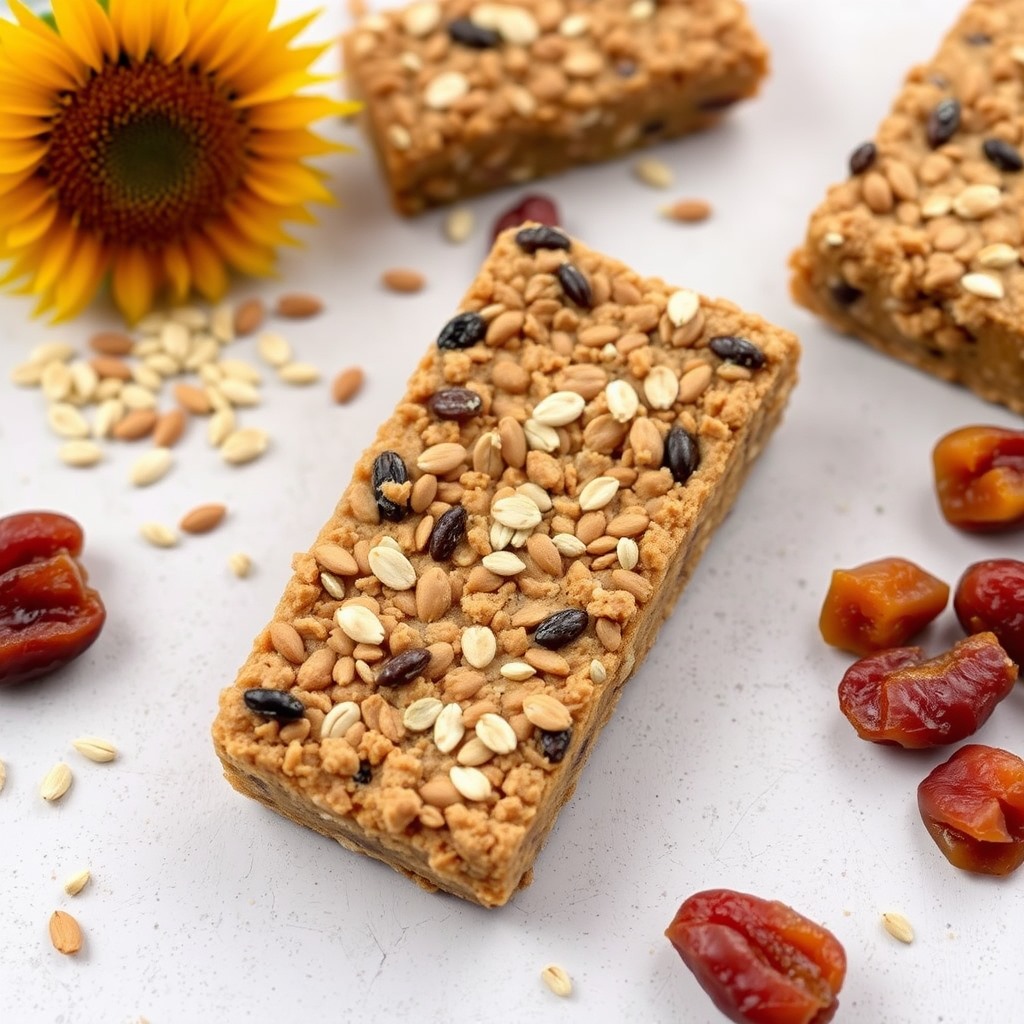
3. Vegan and Gluten-Free Energy Bars
Ingredients
- 2 cups gluten-free oats
- 1 cup dates (pitted and chopped)
- ½ cup sunflower seeds
- ½ cup almond butter
- ¼ cup maple syrup
- ½ teaspoon sea salt
Instructions
- In a food processor, pulse the oats and dates until combined.
- Add the almond butter, maple syrup, and sea salt; pulse until a dough forms.
- Press the mixture into a lined baking pan.
- Refrigerate for at least 2 hours before cutting into bars.
Nutritional Benefits
- Sunflower seeds: High in vitamin E and beneficial fats.
- Dates: Natural sweetness and high in fiber.
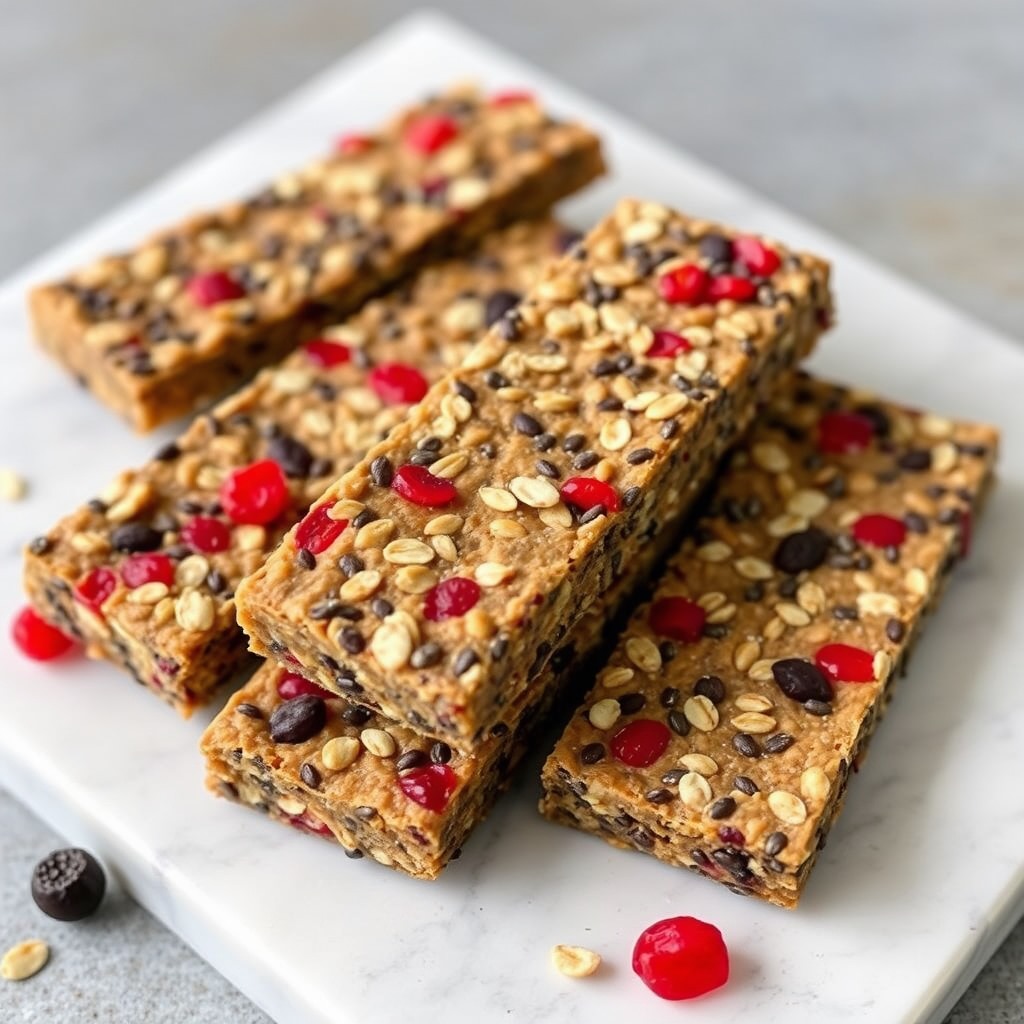
4. Superfood Energy Bars
Ingredients
- 2 cups rolled oats
- ½ cup chia seeds
- ½ cup goji berries
- ½ cup almond butter
- ⅓ cup honey or agave syrup
- 1 teaspoon vanilla extract
Instructions
- In a bowl, combine oats, chia seeds, and goji berries.
- In a saucepan, heat almond butter, honey, and vanilla until melted.
- Pour over the dry mixture and combine well.
- Press into a lined pan and refrigerate until firm.
Nutritional Benefits
- Chia seeds: Loaded with omega-3 fatty acids and fiber.
- Goji berries: High in antioxidants and vitamins.
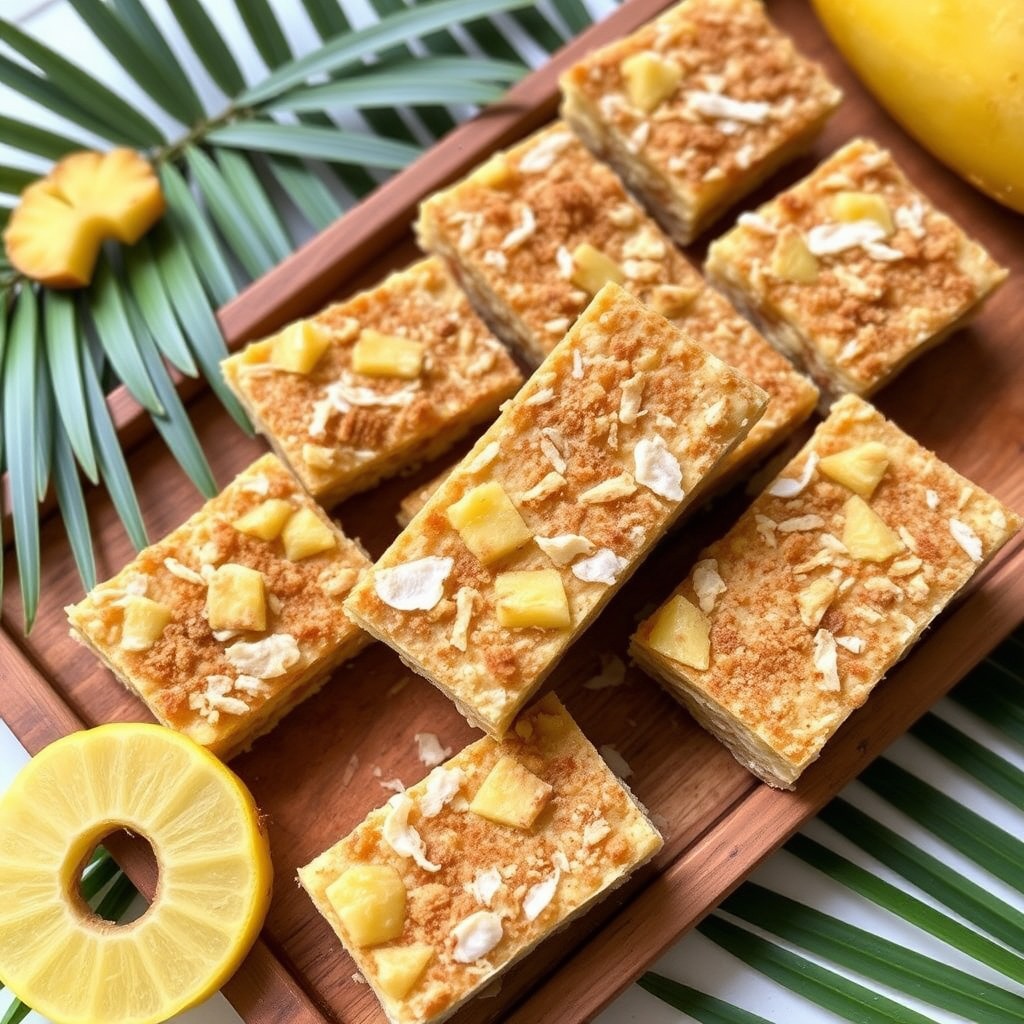
5. Tropical Coconut and Pineapple Bars
Ingredients
- 2 cups rolled oats
- 1 cup dried pineapple (chopped)
- ½ cup shredded coconut (unsweetened)
- ½ cup almond butter
- ⅓ cup maple syrup
- ½ teaspoon cinnamon (optional)
Instructions
- Preheat your oven to 350°F (175°C).
- In a mixing bowl, combine oats, pineapple, coconut, and cinnamon.
- In a saucepan, melt the almond butter and maple syrup together.
- Mix wet ingredients with dry ingredients and press them into a lined baking tray.
- Bake for 15–20 minutes, let cool, and cut into bars.
Nutritional Benefits
- Coconut: Provides healthy fats and adds flavor.
- Pineapple: Contains bromelain, which can aid digestion.
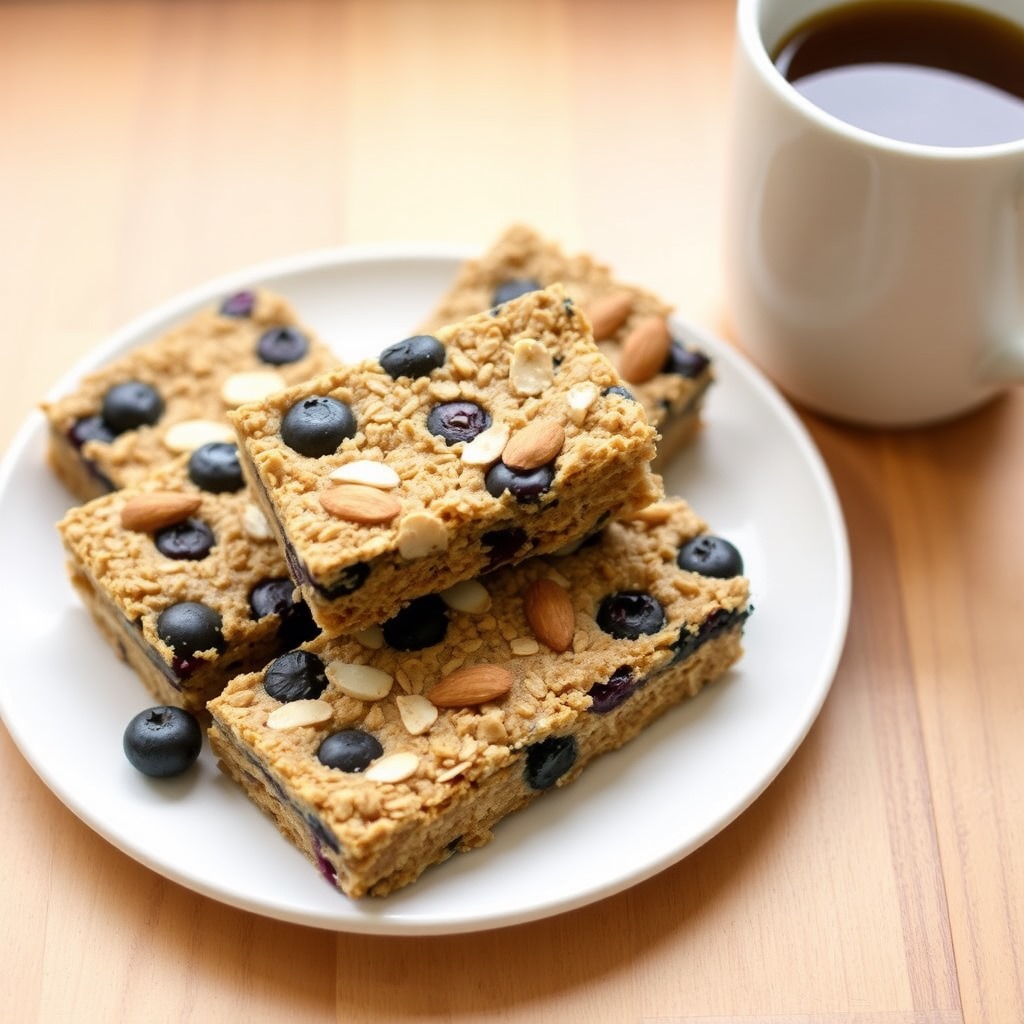
6. Almond & Blueberry Breakfast Bars
Ingredients
- 2 cups rolled oats
- 1 cup almond flour
- ½ cup dried blueberries
- ½ cup almond butter
- ⅓ cup honey or maple syrup
- 1 teaspoon vanilla extract
Instructions
- Preheat oven to 350°F (175°C).
- Mix oats, almond flour, and dried blueberries in a large bowl.
- In a saucepan, melt almond butter, honey, and vanilla extract.
- Combine the wet ingredients with the dry mixture and press into a lined pan.
- Bake for 15–20 minutes, let cool, and cut into bars.
Nutritional Benefits
- Almond flour: High in protein and healthy fats.
- Blueberries: Packed with antioxidants and vitamins.
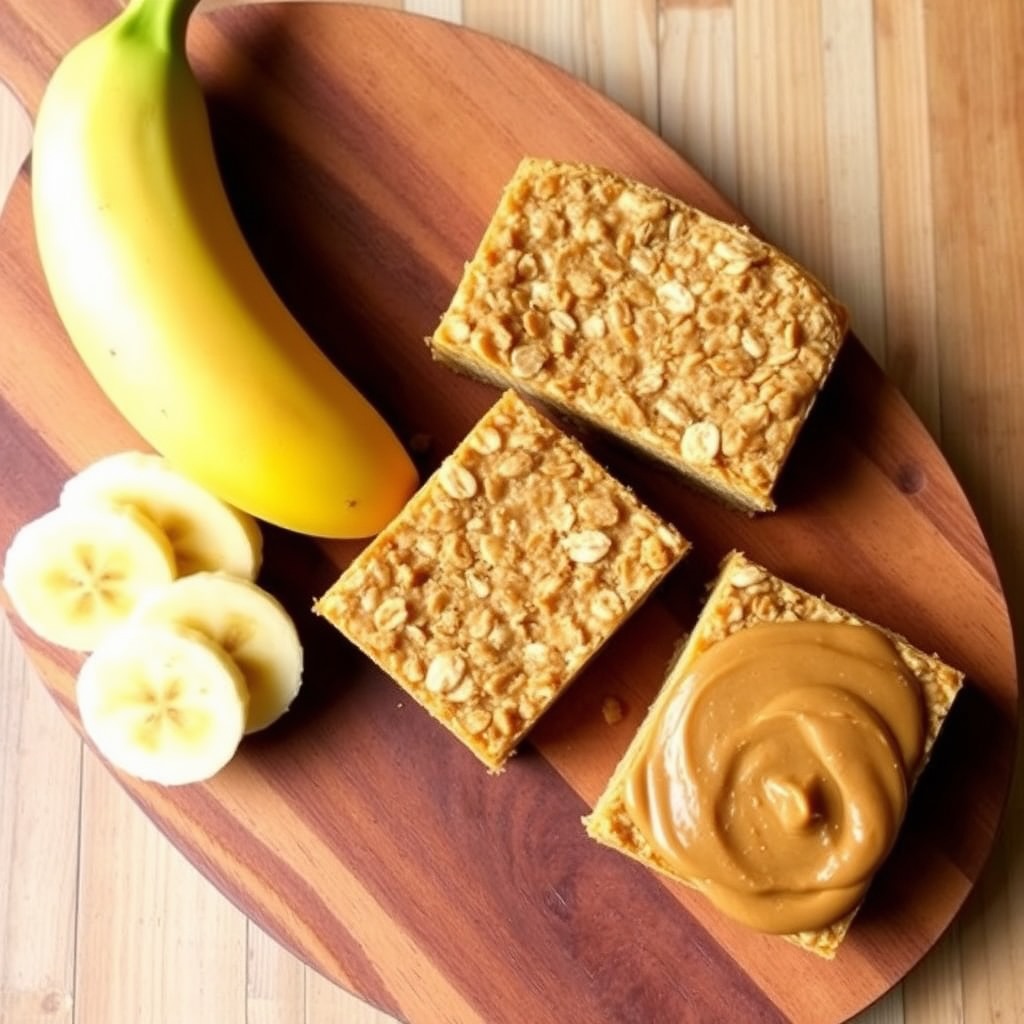
7. Peanut Butter Banana Bars
Ingredients
- 2 cups rolled oats
- ½ cup peanut butter
- 1 ripe banana, mashed
- ¼ cup honey or maple syrup
- ½ teaspoon cinnamon
Instructions
- Preheat oven to 350°F (175°C).
- In a bowl, combine oats, peanut butter, mashed banana, honey, and cinnamon.
- Mix well and spread into a lined baking tray.
- Bake for 15 minutes, then let cool and cut into bars.
Nutritional Benefits
- Bananas: High in potassium and natural sugars for quick energy.
- Peanut butter: Provides protein and healthy fats.
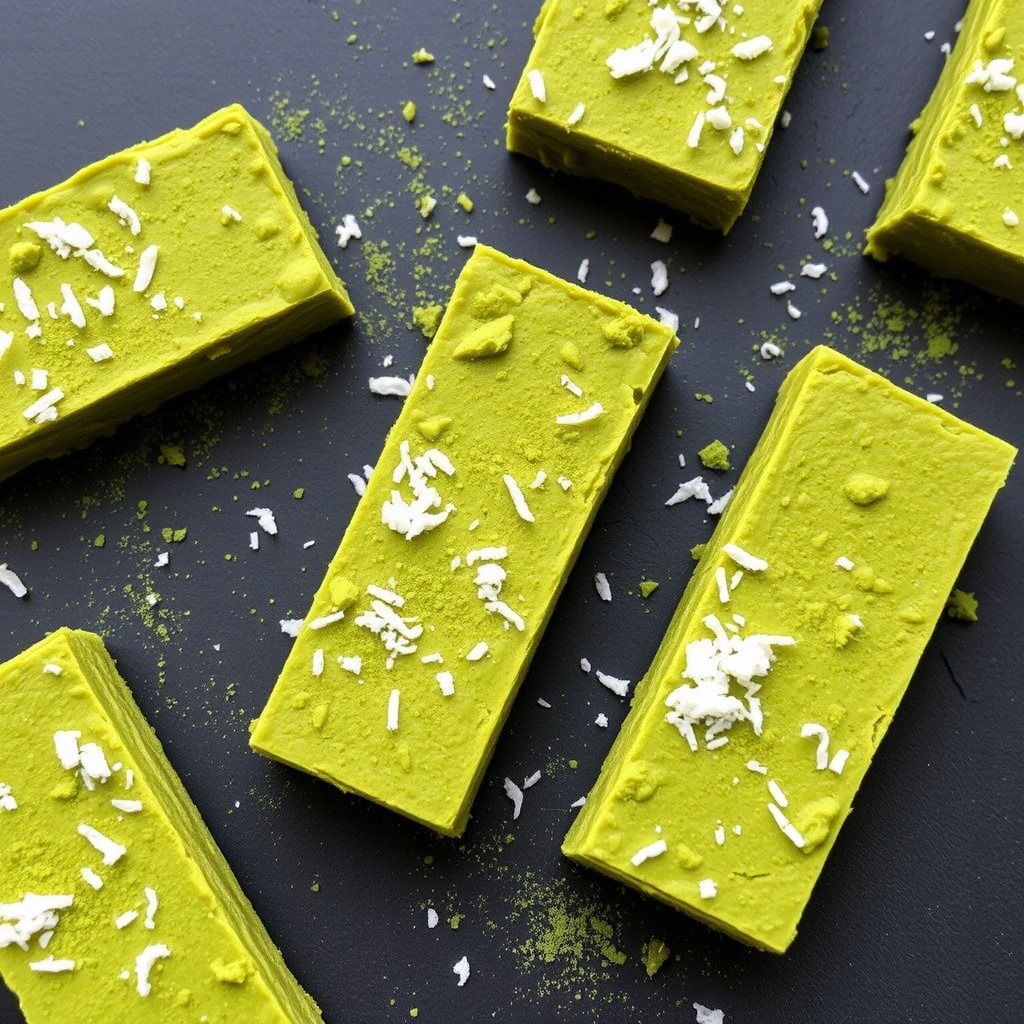
8. Matcha Green Tea Bars
Ingredients
- 2 cups rolled oats
- 1 tablespoon matcha powder
- ½ cup cashew butter
- ⅓ cup honey or agave syrup
- ½ cup shredded coconut
Instructions
- In a bowl, combine oats, matcha powder, and shredded coconut.
- In a saucepan, melt cashew butter and honey.
- Pour the wet mixture over the dry ingredients and combine well.
- Press into a lined baking pan and refrigerate until firm.
Nutritional Benefits
- Matcha: Rich in antioxidants and can boost metabolism.
- Cashew butter: Contains healthy fats and minerals.
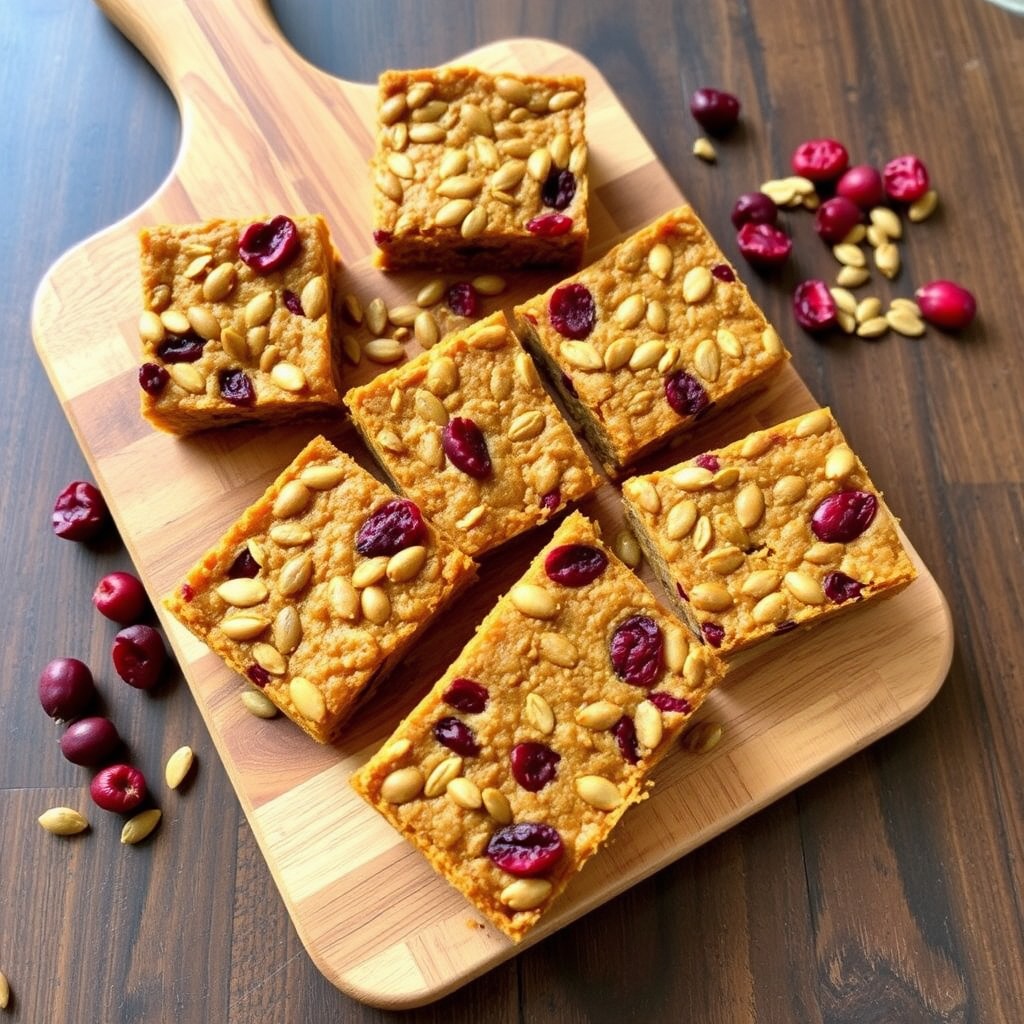
9. Pumpkin Seed & Cranberry Bars
Ingredients
- 2 cups rolled oats
- ½ cup pumpkin seeds
- ½ cup dried cranberries
- ½ cup sunflower seed butter
- ⅓ cup honey or maple syrup
Instructions
- Preheat oven to 350°F (175°C).
- In a bowl, combine oats, pumpkin seeds, and cranberries.
- In a saucepan, melt sunflower seed butter with honey.
- Combine wet and dry ingredients, press into a lined tray, and bake for 15–20 minutes.
- Cool before cutting into bars.
Nutritional Benefits
- Pumpkin seeds: High in magnesium and protein.
- Cranberries: Good source of antioxidants and fiber.
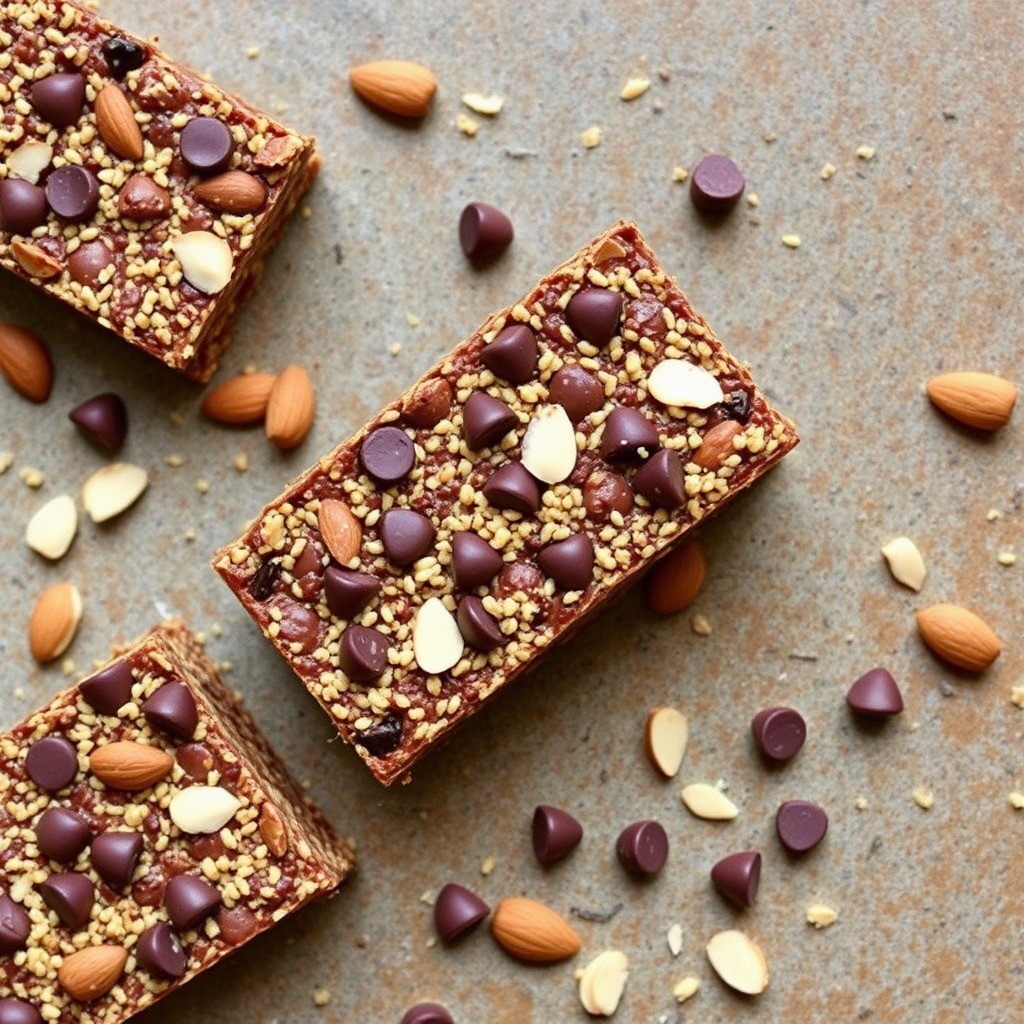
10. Chocolate Almond Quinoa Bars
Ingredients
- 1 cup cooked quinoa
- 1 cup rolled oats
- ½ cup almond butter
- ¼ cup dark chocolate chips
- ⅓ cup honey or maple syrup
Instructions
- Preheat oven to 350°F (175°C).
- Mix quinoa, oats, almond butter, and honey in a bowl.
- Stir in chocolate chips and press the mixture into a lined pan.
- Bake for 15–20 minutes, then let cool before cutting.
Nutritional Benefits
- Quinoa: Provides complete protein and essential amino acids.
- Dark chocolate: Adds antioxidants and can help boost mood.
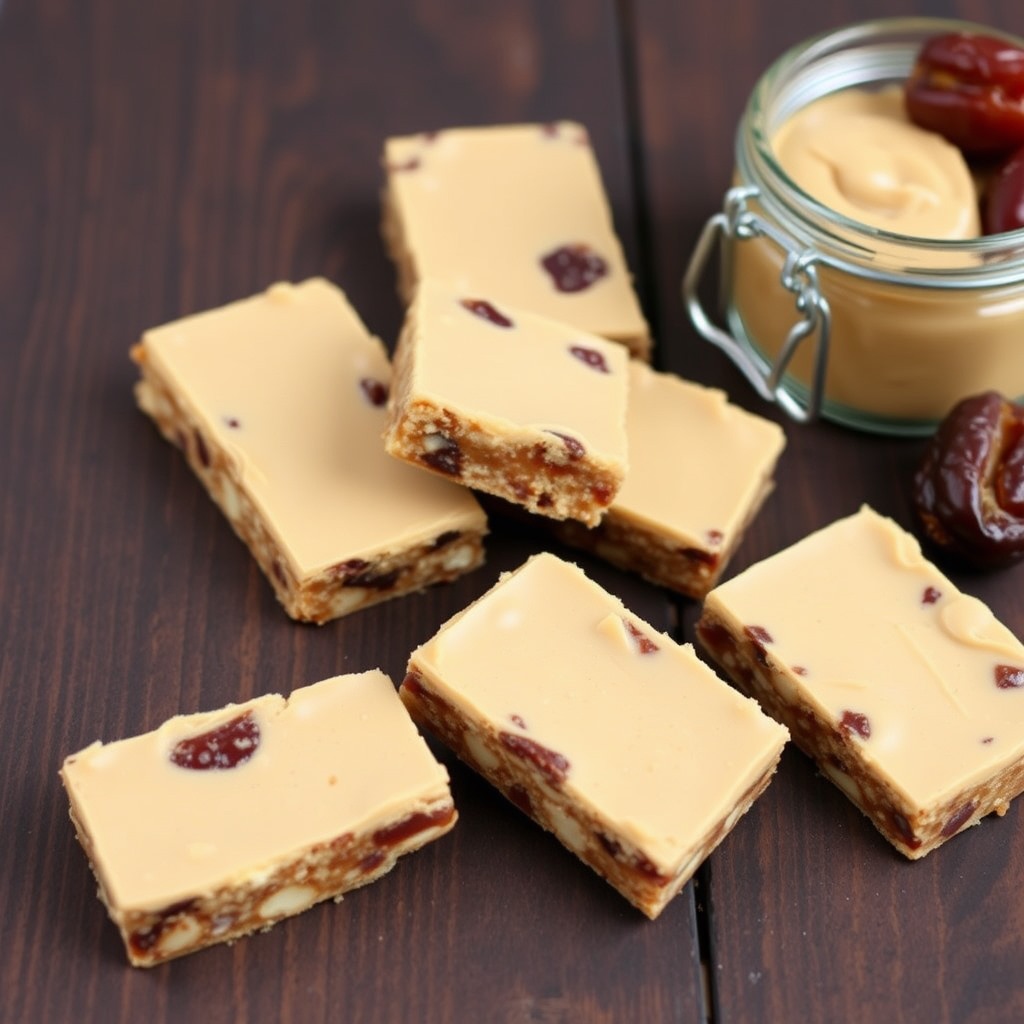
11. Tahini Date Bars
Ingredients
- 2 cups rolled oats
- 1 cup pitted dates, chopped
- ½ cup tahini
- ⅓ cup honey or maple syrup
- 1 teaspoon vanilla extract
Instructions
- In a food processor, blend oats and dates until well combined.
- Add tahini, honey, and vanilla; pulse until a dough forms.
- Press into a lined baking tray and refrigerate for at least 2 hours.
Nutritional Benefits
- Tahini: Rich in calcium and healthy fats.
- Dates: High in natural sugars and fiber for sustained energy.
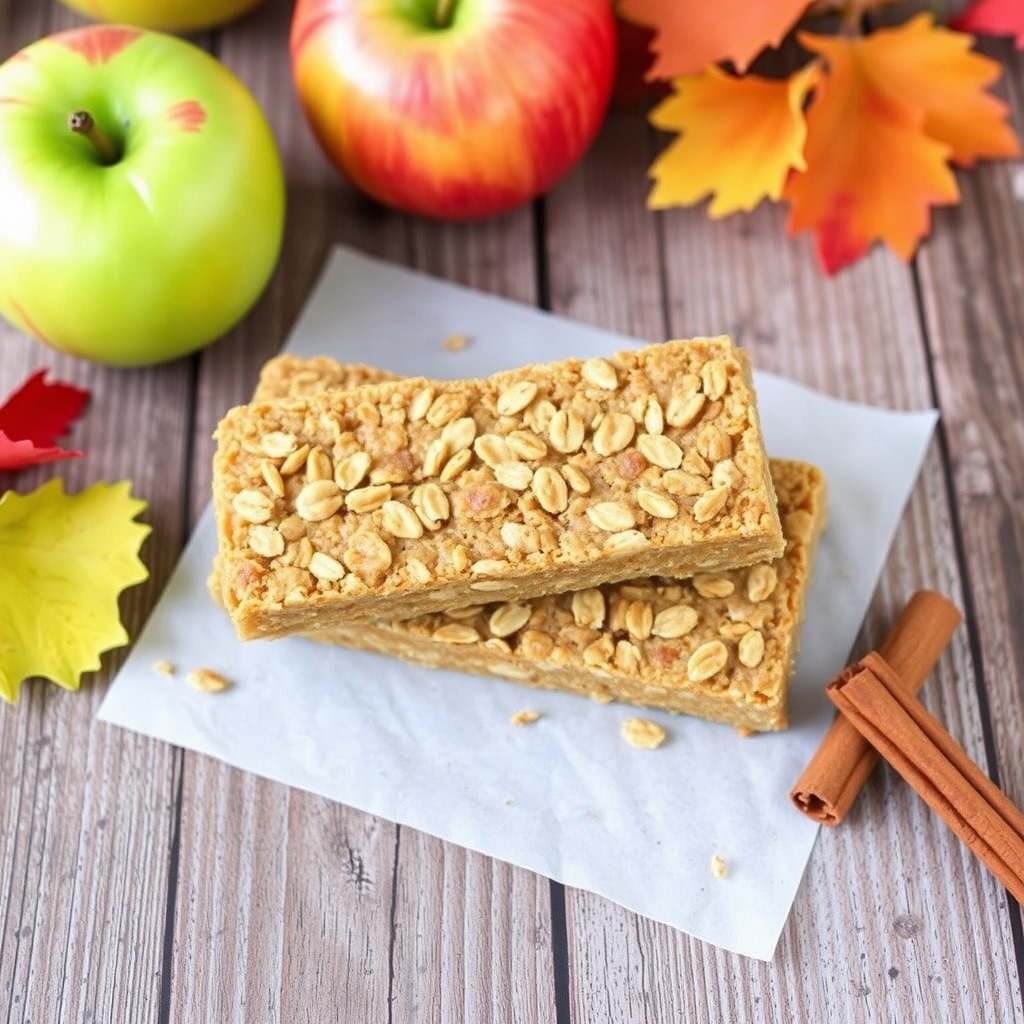
12. Apple Cinnamon Energy Bars
Ingredients
- 2 cups rolled oats
- ½ cup unsweetened applesauce
- 1 teaspoon cinnamon
- ½ cup almond butter
- ⅓ cup honey or maple syrup
Instructions
- Preheat oven to 350°F (175°C).
- In a bowl, combine oats, applesauce, cinnamon, almond butter, and honey.
- Mix well and press into a lined baking tray.
- Bake for 15–20 minutes, let cool, and cut into bars.
Nutritional Benefits
- Applesauce: Provides natural sweetness and fiber.
- Cinnamon: May help regulate blood sugar levels.
Storing Your Homemade Energy Bars
Storing your homemade energy bars properly is crucial for maintaining their freshness, taste, and nutritional quality. Here are some effective storage methods to consider:
Storage Methods
1. Room Temperature
- Duration: 1 week
- Method: Store in an airtight container away from direct sunlight. For best results, separate layers with parchment paper to prevent sticking.
2. Refrigerator
- Duration: 2-3 weeks
- Method: Place the bars in an airtight container. Refrigeration slows down spoilage and keeps the bars fresher longer.
3. Freezer
- Duration: Up to 3 months
- Method: Wrap each bar in plastic wrap and then place them in a freezer-safe container or zip-top bag. Thaw them in the refrigerator before consuming.
Packaging Tips
- Individual Wrapping: For convenience, wrap each bar individually in parchment paper or beeswax wraps.
- Labeling: If freezing, label the container with the date made, so you can keep track of freshness.
Shelf Life Summary
| Storage Method | Duration | Notes |
| Room Temperature | 1 week | Airtight container |
| Refrigerator | 2-3 weeks | Best for longer freshness |
| Freezer | Up to 3 months | Wrap individually for convenience |
Nutritional Benefits of Homemade Energy Bars
Homemade energy bars are not just convenient snacks; they also provide a plethora of nutritional benefits. Understanding these advantages can help you make informed decisions about your snacking habits.
Balanced Macronutrients
Homemade energy bars typically contain a balanced ratio of carbohydrates, proteins, and healthy fats, making them an ideal source of sustained energy.
1. Carbohydrates
- Sources: Oats, fruits, and natural sweeteners.
- Benefit: Serve as the primary energy source, replenishing glycogen stores.
2. Proteins
- Sources: Nuts, seeds, and protein powders.
- Benefit: Essential for muscle repair and growth, helping to keep you feeling full.
3. Healthy Fats
- Sources: Nut butters and seeds.
- Benefit: Important for hormone production and nutrient absorption, contributing to overall health.
Nutrient Density
Homemade bars often contain a variety of vitamins, minerals, and antioxidants due to the use of whole, organic ingredients.
Tailored Nutrition
Making your own energy bars allows you to customize ingredients based on dietary needs:
- Vegan: Use plant-based ingredients like almond or sunflower seed butter.
- Gluten-Free: Opt for gluten-free oats and avoid any gluten-containing ingredients.
- Low-Sugar: Use fruits like bananas or applesauce for natural sweetness instead of added sugars.
Examples of Nutritional Content
A typical homemade energy bar can contain:
- Calories: 150–250 per bar (depending on size and ingredients)
- Protein: 5–10 grams
- Fat: 7–15 grams (mainly from nuts and seeds)
- Carbohydrates: 20–30 grams (mainly from oats and dried fruits)
Cost-Effectiveness of Homemade Energy Bars
While store-bought energy bars can be convenient, they often come with a high price tag. Making your own can be significantly more economical. Let’s break down the costs involved and the potential savings you can achieve.
Cost Comparison
1. Store-Bought Energy Bars
- Average Price: $1.50 to $3.00 per bar
- Monthly Cost (assuming 10 bars): $15 to $30
2. Homemade Energy Bars
- Average Cost of Ingredients (for 12 bars):
- Oats: $2.00
- Nuts: $5.00
- Nut Butter: $3.00
- Sweetener: $2.00
- Total: $12.00
- Cost per Bar: $1.00
Savings Summary
| Energy Bar Type | Cost per Bar | Monthly Cost (10 Bars) |
| Store-Bought | $1.50 – $3.00 | $15 – $30 |
| Homemade | $1.00 | $10 |
Bulk Buying
Purchasing ingredients in bulk can further reduce costs. Common ingredients such as oats, nuts, and sweeteners are often available at a lower price when bought in larger quantities.
Reducing Waste
Making your own energy bars also contributes to reducing packaging waste associated with store-bought options, supporting a more sustainable lifestyle.
Troubleshooting Common Issues
When making homemade energy bars, you might encounter some common issues. Here’s how to address these problems effectively.
1. Bars Too Crumbly
- Cause: Insufficient binding agent or too many dry ingredients.
- Solution: Increase the amount of nut butter or sweetener, or add a few tablespoons of water or milk to help the mixture hold together.
2. Bars Too Sticky
- Cause: Excessive binding agent or moisture.
- Solution: Add more dry ingredients, like oats or protein powder, to balance the moisture content.
3. Flavor Too Bland
- Cause: Lack of seasoning or flavor enhancers.
- Solution: Add spices (like cinnamon or vanilla), sea salt, or additional sweeteners to enhance flavor.
4. Texture Too Hard or Dry
- Cause: Overbaking or not enough binding agent.
- Solution: Reduce baking time and ensure you’re using enough sticky ingredients.
5. Difficulty Cutting Bars
- Cause: Bars not chilled enough or too soft.
- Solution: Allow the bars to cool completely or refrigerate them longer before attempting to cut.
Tips for Perfect Bars
- Experiment with ingredient ratios to find your preferred texture and flavor.
- Always let the bars cool completely before cutting to prevent them from falling apart.
- Store any leftover bars properly to maintain freshness.
Conclusion
Making your own organic energy bars at home is not only a rewarding experience but also a smart choice for your health and wallet. With the ability to customize flavors, control ingredients, and save money, homemade energy bars can fit seamlessly into your lifestyle. Whether you’re looking for a quick snack on-the-go or a nutritious pre-workout boost, these bars are the perfect solution. Embrace your creativity in the kitchen and enjoy the countless benefits of homemade energy bars!
Appendices
To provide additional value and resources, this appendix section includes helpful information, conversion tables, FAQs, and further reading suggestions related to making your own organic energy bars.
A. Conversion Tables
When creating energy bars, precise measurements are key to achieving the perfect texture and flavor. Here are some common conversions for your convenience:
| Measurement | Equivalent |
| 1 cup | 8 fluid ounces |
| 1 tablespoon | 3 teaspoons |
| 1 ounce | 28.35 grams |
| 1 pound | 16 ounces |
Common Ingredient Conversions
| Ingredient | 1 Cup | 1/2 Cup | 1/4 Cup |
| Rolled Oats | 90 grams | 45 grams | 22.5 grams |
| Almond Butter | 250 grams | 125 grams | 62.5 grams |
| Honey | 340 grams | 170 grams | 85 grams |
| Chopped Nuts (Mixed) | 150 grams | 75 grams | 37.5 grams |
| Dried Fruits (Chopped) | 150 grams | 75 grams | 37.5 grams |
B. Frequently Asked Questions (FAQs)
1. Can I substitute ingredients in the recipes?
Yes! Feel free to substitute based on your dietary preferences or what you have on hand. For example, you can use different nuts, seeds, or sweeteners.
2. How long do homemade energy bars last?
If stored properly, homemade energy bars can last up to one week at room temperature, two to three weeks in the refrigerator, and up to three months in the freezer.
3. Can I make these bars without baking?
Absolutely! Many recipes can be made without baking by simply chilling the mixture in the fridge until firm.
4. Are these bars suitable for kids?
Yes! Homemade energy bars can be a healthy snack for kids, but be sure to choose ingredients that are age-appropriate and monitor for potential allergens.
5. How can I make these bars higher in protein?
To increase protein content, consider adding protein powder, nuts, seeds, or Greek yogurt into your recipes.
C. Further Reading
If you’re interested in diving deeper into the world of nutrition, energy bars, and organic ingredients, consider exploring these resources:
- Books:
- The Energy Bar Cookbook by Lisa McCarthy: A comprehensive guide to making various energy bars.
- Superfoods: The Food and Medicine of the Future by David Wolfe: Insights into nutrient-dense foods.
- Websites:
- USDA Organic: Learn about organic farming practices and certifications.
- Nutrition.gov: A reliable resource for dietary guidelines and nutritional information.
- Research Articles:
- “Health benefits of whole grains” published in the American Journal of Clinical Nutrition: A deep dive into the nutritional advantages of whole grains.
- “Plant-based diets and their impact on health” in the Journal of Geriatric Cardiology: A look into the benefits of plant-based diets.
D. Community and Sharing
Creating energy bars is not just a personal endeavor; it can also be a community experience. Consider joining online groups or forums where home cooks share their recipes, tips, and experiences. Platforms like Pinterest, Instagram, or dedicated Facebook groups can provide inspiration and allow you to connect with others who share your passion for health and nutrition.

